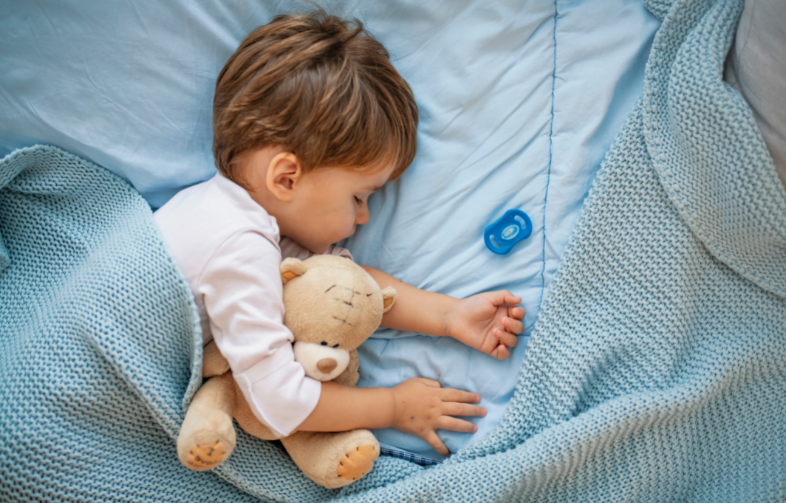Sleep is critical to a child’s growth, it is an important issue for parents of young children. Yet so many kids are missing out on proper sleep.
The American Academy of Pediatrics noted in their research that only 48% of school aged kids in the United States get 9 hours of sleep a night. The consequences of those who didn’t included a decrease of interest in school and a harder time handling everyday childhood challenges.
It is not just school aged kids missing out on sleep, a quarter of children under 5 are also not getting enough sleep.
Bedtime routines will help improve your child’s sleep quality and quantity.
How do you build a bedtime routine for kids?
You build the routine by establishing certain actions you do every night in the same order, that is aimed at comforting your child and giving their bodies and minds cues that it is time to settle down and rest. Things like dimming lights, warm showers, no electronics an hour before bed and reading a book are all tools that will help minimize any fuss in your child’s bedtime routine.
In this post we will discuss how to build a bedtime routine for your child with science backed step by step suggestions, and why a bedtime routine and adequate sleep are critical to your child’s development.
What do we mean by a bedtime routine and why is it important?
A routine is a sequence of actions regularly followed. Something done the same way, in the same order, everytime it is done.
Kids thrive on routines. It gives them structure, it gives them something to look forward to and helps them be comfortable and secure in their home environment and life. Routines for kids set expectations and gives them consistency.
Setting a bedtime routine means doing a set of actions in the same order every night.
This gives your child’s body and mind cues that it is time to sleep, it helps them relax their minds and fall asleep easier. When kids get into a bedtime routine their body naturally gets into a rhythm of sleeping at approximately the same time and waking up at the same time.
There are different parenting styles, but there are some things that cannot be compromised. Your young child’s sleep is one of them. We aren’t perfect parents, oh god no…so far from it!
BUT!
we share what we feel we have a good grasp on through experience and learn from others on stuff we want to improve on.
A sleep routine is something important most parents have a grasp on, and that we have incorporated in both our children since birth, but there are horror stories we hear that are very concerning.
4 year olds staying up at night after night until 2 or 3 in the morning because “they won’t sleep” playing on their IPADs or electronics.
The detrimental effects this has on your child is not small, and there should never ever be a reason a scenario like that is a child’s daily bedtime routine.
This doesn’t mean an individual is a bad parent, it is usually a lack of understanding on how important a bedtime routine is.
How to build a bedtime routine?
The first thing we need to build a bedtime routine is to have an idea of just how much sleep a child needs. Below is a quick guide on how much sleep a child needs which we also shared on our Kids Need Naps blog post.
We made our own graph using the data shared:

Now to the actual routines. Every routine here will be centered around our main bedtime routine PILLARS, which are:
Pillar #1: Start Early
Pillar #2: Relax the environment
Pillar #3: The Three B’s : Bed, Book, Bath.
Routine for newborns and infants:
Newborns and babies can still have a routine but they need much more attention and care than toddlers and kids so there are many differences. Along with a routine for a newborn/infant we also provided some recommendations to help them sleep better and minimize any baby fuss.

Here is a bedtime routine for newborns/infants that worked for us:
♦Nice warm bath
♦Play soothing sleep/baby music or sing/hum to them
♦Gently massage their bodies after the bath with lotion. If you can use calming baby lotion even better. This just helps your baby’s body relax, comfort them and promote rest/sleep.
♦As you are doing this, humming and singing soft music to your baby helps.
♦Let your baby share a room with you during their first months of life. Not only are you able to keep a closer eye on your baby for safety, but when it’s time for feeding they are right next to you in their basinets.
♦If they sleep on their own invest in a baby swaddle. This helps them feel similar comfort they felt in your womb, and helps them sleep longer aside from waking up to feed. A swaddle comforts a baby from their own natural reflexes which can help them sleep better.
♦Once you are ready for them to sleep on their own, sleep train them. Sleep training is another topic, but one thing we can advise is don’t let them “cry it out”.
It is one thing not picking them up from their cribs, but go in there and reassure them. Sing to them, rub their back and gradually keep leaving them alone longer and longer.
There are many different methods for sleep training your babies.
We recommend either the “Fading” method or The Ferber Method as detailed in Fatherly.
Routine for toddlers to school aged kids:
Here our 3 pillars are critical.
Babies are more complex, but at this stage (toddlers to school aged) a routine should be set, and your child should know what to expect.
Pillar #1: Start early.
Reference the graph above and figure out when your child needs to wake up and make sure they are getting enough hours of sleep.
Remember to supplement their necessary sleep with naps as detailed in our KIDS NEED NAPS post.
We recommended starting an hour to an hour and half before you want your kids in bed and lights off. This gives you time to troubleshoot any last minute issues. But we know kids never cause any last minute issues, right?
Pillar #2: Relax the environment.
An hour to an hour and a half before it is lights out and they are in bed, turn off all electronics.
No tablets, ipads, video games or television.
It has been shown, that the artificial light emitted by electronic devices like television, phones and tablets, send signals to the brain to remain awake.
This disrupts sleep and has been shown to disrupt sleep to a greater extent in children if the devices are used within the hour before bed time.
ALERT! WARNING! DON’T READ THE NEXT PARAGRAPH IF YOU ARE EASILY OFFENDED!
It is just unacceptable, and we cannot sugar coat it or be nice about it, that any parent would allow their 4 or 5 year old child to go to sleep with a tablet or ipad in their hands and allow them to be on it until 2 or 3 in the morning. Yes, these are real life scenarios. We understand we have to pick and choose our battles, but this battle you are letting a child win will have deep detrimental effects on their well being.
Pillar #3: The three B’s – Bath, Book, Bedtime
1.Bath: If they are on the younger side, or you start early enough, give them time to relax and play in a nice bath. This time serves as a nice transition from being awake to giving their bodies cues that it is time to relax.
Once they are bathed, don’t stop using lotion and calming lotion if possible. It is just a soothing activity that will help relax their bodies.
Brush their teeth and encourage them to use the bathroom before heading in to the room.
Parent Tip: once they are in the room, you want to minimize them leaving the room and getting distracted. Make sure they have any stuffed animals they want to sleep with, they used the bathroom, and have their water bottles handy in case they get thirsty.
2.Book: Once they are in their rooms, we recommend finding a way to dim the lights or turn off some lights with just enough to read a book. Again, this is all about sending cues to their minds and bodies that it is time to wind down.
We like to let our kids choose a book each, or one book together if it is getting late.
Books at bedtime have been shown to help expand their vocabulary, improve their language skills and reduce their hyperactivity.
3.Bedtime: After reading the books, tuck them in their beds.
Some things that can help in this bedtime routine are:
- Take a relaxing demeanor yourself, children feed off your own emotions.
- Talking in a softer, slower, voice.
- Investing in a light machine.
- Investing in a sound machine.
- Try to shut off the lights at around the same time every night. A few minutes won’t make a difference but try to keep it within 5-10 minutes. We have found that when we shut off the lights and have them in bed by an exact time (literally by the minute) they always fall asleep much easier. Again, it is all about a ROUTINE. Routines help kids thrive and handle everything in their little lives much easier.
Please note that if your kids are not use to a bedtime routine, they might be a bit reluctant to follow a new one. This is ok, it is expected. Follow through and in a couple of weeks they will adapt.
In conclusion, sleep is one of the most important tools to help our children grow up and develop properly during their childhood years. We must pay special attention to it, include naps, and have a bedtime routine for them every night that will help facilitate and maximize their sleep.
The routine should involve the three pillars described above:
- Start early
- Relax the environment
- Bath, book, bedtime sequence!
Thanks for reading! If this helped you in anyway, please let us know and share!


One thought on “A no fuss Bedtime Routine for your child (Babies and Kids)”